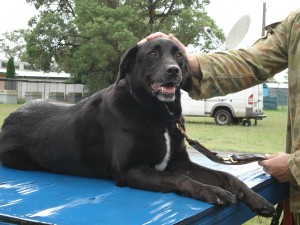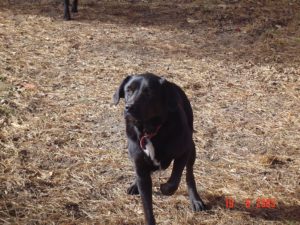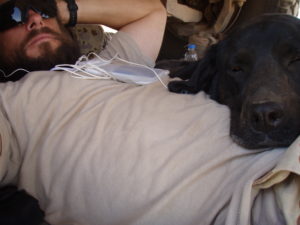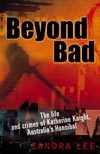AUSTRALIA’S best known and much-loved war dog, Sarbi, will have a new fur-ever home – and her thousands of fans will be able to visit her.
Sarbi will “live” on in perpetuity in the heart of the Australian War Memorial when a new exhibition opens next week with the hero hound as the star attraction.
The mortal remains of the highly decorated Explosive Detection Dog were donated to the war memorial by her trainer and handler, Warrant Officer David Simpson (ret) and his wife, Kira, and have been preserved in taxidermy.
“Sarbi looks really good. I am very confident people, especially children, will be attracted to her,” memorial director, Dr Brendan Nelson told me. “Dave gave advice on Sarbi’s characteristic pose…she has her paw up and that nice smiling face.”
Sarbi died from brain cancer in early 2015. The 12-year-old had completed three deployments to Afghanistan with Simpson as part of the elite EDD Section in the Australian Army. She has the highest number of decorations of any war animal, among them the prestigious Purple Cross for animals that have shown outstanding courage in service to humans.
She is one of dozens of highly skilled sniffer dogs who have served in Afghanistan since 2002, saving the lives of thousands of their fellow two-legged soldiers by seeking out the enemy’s lethal explosive devices.
“I think Sarbi, in representing all of these dogs, stimulates our imagination to reflect on the loyal and loving nature of these animals and their skills,” Dr Nelson said.
“The bond between these dogs and their handlers is just as strong as that as between the men and women themselves.”
The beautiful Newfoundland-Labrador cross joins other preserved four-legged heroes at the memorial including a horse, which represents the Light Horsemen of the Australian Imperial Force, and a camel, which also served in the First World War in the Camel Corps. My bet is that Sarbi will become as popular as the legendary racehorse, Phar Lap, who is on display at Museum Victoria.
W.O. Simpson, who retired from the Australian Army in 2015 after 20 years, trained Sarbi from the first moment she joined the Australian Defence Force in 2005. She made her professional debut at the Commonwealth Games in Melbourne in 2006.
He has said he made the decision to donate Sarbi for display at Australia’s preeminent war memorial because of the extraordinary response the hero hound had received from thousands of people both in Australia and around the world.
“I only thought it fair to do this to enable so many more people to learn about Sarbi and draw inspiration from her story,” he wrote.
Sarbi and Simpson were on their third deployment to Afghanistan when the beautiful black Labrador-cross (technically, a mutt) went missing in one of the most dangerous Special Operations missions in Uruzgan Province 2008. Her full story is told in my book, Saving Private Sarbi, The True Story of Australia’s Canine War Hero.
A joint Australian, Afghan and US task force was on an overnight patrol when they were attacked in a life-and-death ambush by a greater number of Taliban fighters as they returned to their remote outpost, Forward Operating Base Anaconda.
Nine of the 12 Australians in the operation were injured, including Simpson who underwent surgery the following day to remove shrapnel from his arms and torso. Tragically, his American counterpart, dog handler Sergeant First Class Gregory Rodriguez, was killed in the action though his dog, Jacko, survived. Several members of the Afghan Forces were seriously wounded.
At the end of the running battle Sarbi was missing, and was later taken a ‘prisoner of war’ by the Taliban.
It was the same battle for which SAS Trooper Mark Donaldson would later be awarded the prestigious Victoria Cross for his courage under fire.
Sarbi was finally retrieved in a surprise ‘dog-napping’ by a US Special Forces soldier 13 months later in 2009 and returned to the Australian Army, ultimately being repatriated to Australia in 2010.
Upon her return to the Australian base at Tarin Kot in 2009, she became an instant pup-star, and her story captivated Australians.
Sarbi will be a permanent part of the new Middle East display in the ‘Existing Conflicts 1945 to Today‘ gallery, focusing on the First Gulf war in 1991 as well as the Maritime Interception Force, United Nations Weapons Inspections from 1991-1999, and the wars in Afghanistan and Iraq.
The new exhibition will feature a picture of Simpson with Sarbi resting in the shade during a patrol in Tarin Kot in 2007. Other objects on display will include Simpson’s shrapnel damaged ANF patch, bullet fragments removed from his body, and Sarbi’s booties, which she often wore while on patrol to protect her paws from the elements.
This latest tribute to the Doggies (as the EDD dog and handler are affectionally known) at the Australian War Memorial joins a beautiful sculpture in the garden near Poppy’s Cafe called Elevation of The Senses, created by Melbourne artist Ewan Coates and unveiled in October last year, thanks to a generous donation of Sydney man Doug Thompson and his late wife, Monique.
The bronze statue features an EDD team with the canine raised to eye level with his handler, to illustrate the incredible bond between human and hound. The sculpture also features the names of the six Explosive Detection Dogs who have lost their lives while serving their fellow two-legged soldiers in Afghanistan.
Significantly, however, the artwork includes the name of Sapper Darren Smith, who was killed by an enemy Improvised Explosive Device with his dog, Herbie, during an operation in 2010, along with fellow Sapper, Jacob Moerland.
Dr Nelson said some people complained that the animal sculpture should not include Sapper Smith’s name, but he argued it should.
“I said that’s the point. It illustrated the sense of equality and mutual respect between the dog and the handler. When we were commissioning it, I rang Darren Smith’s father and he told me that before Darren and Herbie deployed to Afghanistan, Herbie had an operation and Darren slept at the vet’s for three nights with Herbie. And they are buried alongside each other, not separately – that’s the relationship.
“And that’s the paradox of the Australian War Memorial; it’s not about war, it’s about love and friendship…and that love and friendship exists between these handlers and the dogs, and the dogs with other soldiers. They would not go anywhere without them.
“In a funny way, Sarbi humanises the telling of the story. For all the technical complexities and cutting edge technologies [of war], there is nothing superior to the olfactory senses of the dog. And the other thing is the dogs – among other things – remind the men and women of home.”
Sarbi and the new exhibit featuring the EDD Section will be open to the public at the AWM from Thursday, October 6. For more information, visit the memorial website here.




